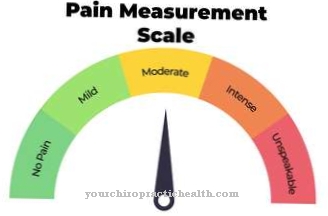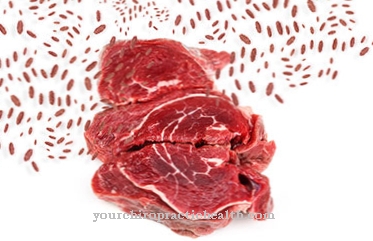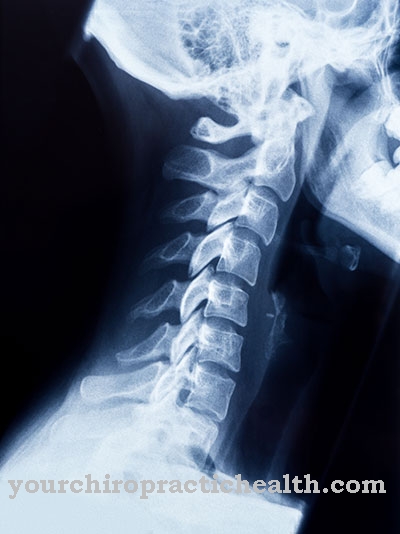Most people are familiar with acne as a skin disease that leads to more or less severe visual impairment of the skin. For this reason, especially many young people of puberty fear a so-called Acne inversa to develop.
What is acne inversa?

Acne inversa is a skin disease. Acne inversa is an inflammatory process that affects certain functional parts of the skin and is limited to different parts of the body.
According to the definition, acne inversa is about inflammation foci, which refer to the sebum glands located under the skin and the so-called hair follicles. Acne inversa can develop in both men and women. However, the majority of men suffer from this skin disease.
causes
When researching the causes that lead to the development of acne inversa, doctors have come across various factors. However, the clear causes of acne inversa are still unclear.
It is believed that acne inversa is favored by the consumption of nicotine. In addition, acne inversa can be a result of obesity. For this reason the acne inversa is also called Sweat gland abscess designated. Hereditary criteria also play a role in the pathogenesis of acne inversa. It has been proven that acne inversa occurs more frequently within a family.
An influencing factor that takes microorganisms into account must also be included as a cause in acne inversa. In this regard, bacterial infections are primarily responsible for the course and severity of acne inversa.
Symptoms, ailments & signs
Acne inversa is a serious disease which can severely impair the quality of life. With complicated courses, even life-threatening sepsis can develop. Both sexes are equally affected, with the multiple abscesses mostly in the anal region in men and often under the armpits in women.
The disease can be divided into three stages. Stage I has multiple skin abscesses that do not scar or form fistulas. They are giant comedones (blackheads) that appear as firm and palpable lumps in the skin. In stage II, recurrent abscesses are observed that tend to fistula. Pus, sebum or foul smelling secretions can be removed by squeezing.
Stage III is characterized by extensive involvement of one region of the body with multiple abscesses. The resulting fistulas connect with each other. In addition, there are scarred areas from previously burned out abscesses. Acne inversa is characterized by chronic pain, restricted mobility and psychological abnormalities.
Furthermore, the constantly occurring symptoms can often lead to long absences from work, so that the disease is recognized as a social disability. The sick often suffer from social stigmatization due to long periods of absence and are prone to depression. The constant abscesses can also lead to life-threatening complications such as sepsis (blood poisoning).
Diagnosis & course
The course of acne inversa varies from person to person. At the onset of acne inversa, festering blackheads form, which can turn into inflamed nodules and later abscesses.
Acne inversa is characterized by several attacks, so that the times between the individual attacks can be very long or quite short. In most cases, depending on the depth and extent of the skin irritation, acne inversa shows severe or lighter inflammation. Usually, however, the skin tissue affected by acne inversa heals scarring. In addition, so-called fistulous ducts can form with acne inversa.
The individual patients do not always complain of painful complaints, but they feel severely impaired physically and mentally. The specialist (e.g. dermatologist) recognizes the presence of acne inversa through the visual assessment of the skin and the history of the disease presented by the person affected.
Complications
The psychological stress associated with acne inversa is particularly great. Those affected are often ashamed of the unsightly areas of skin, they withdraw and may also be socially excluded. Depression and / or problems in the relationship can follow.
Acne inversa can be associated with severe pain, shortening of tissue and scarring, which can lead to restricted mobility. As a result, everyday life is made more difficult and there may be absenteeism in school or at work. Relatives can also be overwhelmed by the situation.
Bacteria can wash into the bloodstream from sources of inflammation in acne inversa. The risk of a generalized infectious disease known as blood poisoning (sepsis) is increased. Sepsis is accompanied by the symptoms of increasing fever, chills, reddening, swelling, severe pain, overheating at the site of the infection and a strong feeling of illness. Sepsis must be treated immediately.
Further complications related to acne inversa can be recurrent local inflammation and chronic swelling.Certain types of cancer (squamous cell carcinoma) can also be linked to acne inversa.
Acne inversa can also be associated with sleep disorders, obesity, disgust, wetness, disfigurement problems combined with a feeling of shame and impaired sexual life. In addition, there can be soft tissue flooding under the skin due to a disruption in the lymphatic system.
When should you go to the doctor?
For people who are affected by acne inversa, a visit to the dermatologist is recommended in the first of three possible stages. The sooner this severe form of acne is diagnosed and properly treated, the better the dermatologist can get the painful skin disease under control. But often enough it takes a long time to make the correct diagnosis.
Even the pain of the first stage of acne inversa justifies consulting a specialist in skin diseases. However, it often happens that this stage is not recognized as acne inversa. One of the reasons for this is that acne inversa occurs less frequently than other forms of acne. However, nowadays this skin condition is known to most dermatologists. Nevertheless, it is advisable to consult an experienced dermatologist in order not to be exposed to a misdiagnosis.
Under no circumstances should the person concerned squeeze the inflamed and swollen foci of pus. The sooner the acne inversa is correctly recognized and properly treated, the less the person concerned has to suffer. In the first stage of acne inversa, the doctor can still treat conservatively with antibiotics. Women can receive anti-androgen therapy. Surgery or laser treatments are often necessary in the two later stages. If a fistula is suspected, the attending physician can arrange for an X-ray contrast examination.
Doctors & therapists in your area
Treatment & Therapy
After acne inversa has been clarified with microbiologically examined smears or X-ray examinations, treatment can begin. A wide variety of methods can be used in the treatment of acne inversa. If there is no improvement, surgical interventions are also used against the disease. The strongly festering acne foci can be opened surgically.
The easier and less radical treatment options for acne inversa include a change in diet, moist and warm compresses, bathing and hydrotherapy. Enriching the diet with vitamin A and zinc gluconate can also alleviate acne inversa. In addition, drugs that have been specifically used in therapy, which are enriched with corticosteroids and injected directly into the skin, have proven effective.
If there is extensive bacterial inflammation, antibiotic drugs can be prescribed. In order to control the hormonal causes of acne inversa, anti-androgenic procedures are also used.
Outlook & forecast
With proper treatment with prescribed medication, the complexion improves increasingly. The prospect of healing increases when the affected areas of the skin get enough air and do not sweat too much. As with many skin diseases, the cause of acne inversa has not been fully clarified. So there is always hope that one day the disease will go away on its own. Whether the healing will last remains to be seen and depends on many criteria, including the hormone status and the patient's lifestyle.
Without treatment, the disease progresses. Pustules turn into eczema and abscesses that make medical treatment absolutely necessary. Those who do not visit the doctor risk that the bacteria of the acne pustules spread further in the body via the bloodstream. This leads to the outbreak of acne on other skin areas as well. Here the prognosis looks much worse. A complete cure is impossible as the disease gets too many outbreaks.
A connection to smoking is suspected, especially in the case of acne inversa. Over 80% of those affected are smokers. Anyone who gives up smoking and carefully treats the acne usually quickly notices a significant improvement in the clinical picture. The prospect of complete healing is then best.
prevention
Helpful tips for the prevention of acne inversa are not easy to give, especially since the preventive options are extremely limited. In order to avoid an expansion of the inflammatory processes and thus a worsening of the condition, specialist, professional treatment is always preferable. This applies in particular to the frequent opening of the foci of pus.
The risk of developing acne inversa can be limited if you maintain a healthy weight and do not consume nicotine. In women, early drug treatment against the predominance of male hormones can prevent acne inversa in individual cases.
Aftercare
Acne inversa is a protracted illness that is often chronic. After successful therapy, all factors that encourage relapse and flare-up of the disease should be avoided. A care routine that keeps the skin clean but not excessively stressed is helpful.
Regular cleaning of the skin with a mild detergent and a disposable washcloth is recommended. Good results are also achieved with cleaning agents based on micelles, which are applied to the face with a cotton ball. The causes of acne inversa have not yet been conclusively clarified.
However, since there is at least a statistically high correlation with nicotine consumption and obesity, these factors should also be taken into account during follow-up care. Anyone who has stopped smoking as part of therapy is better not to start again later. Overweight patients need to reduce their weight. A change in diet to a largely plant-based diet combined with regular physical activity promises the greatest success.
A healthy diet, which includes a lot of fresh fruit and vegetables in addition to whole grain products, generally has a positive effect on the condition of the skin. When using personal care products and make-up, care should be taken to use only fat-free, non-comedogenic products. If scars have formed during the illness, these can be treated as part of the follow-up care.
You can do that yourself
Acne inversa can only be effectively treated with surgery. However, the symptoms and everyday problems that come with the disease can be treated with a few precautions and home remedies.
So first of all, increased personal hygiene is recommended. Affected areas should be cleaned regularly with a disposable washcloth and mild washing lotions. The dermatologist can also prescribe light ointments which reduce itching and the like. What should be avoided is hair removal by waxing or epilation.
Aggressive peelings are also better avoided because they can irritate the skin. In addition, those affected should stop smoking. By consuming cigarettes, more bacteria of the type Staphylococcus aureus can settle on the skin - the result is an intensification of acne and worsened wound healing.
Finally, dietary measures are recommended. In this way, on the one hand, obesity can be excluded as a risk factor. On the other hand, a healthy and balanced diet without fast food and luxury foods contributes to a better complexion and an increased immune system. However, should severe inflammation develop, it is important to consult a doctor and have the acne inversa professionally removed.


.jpg)









.jpg)



.jpg)










.jpg)
